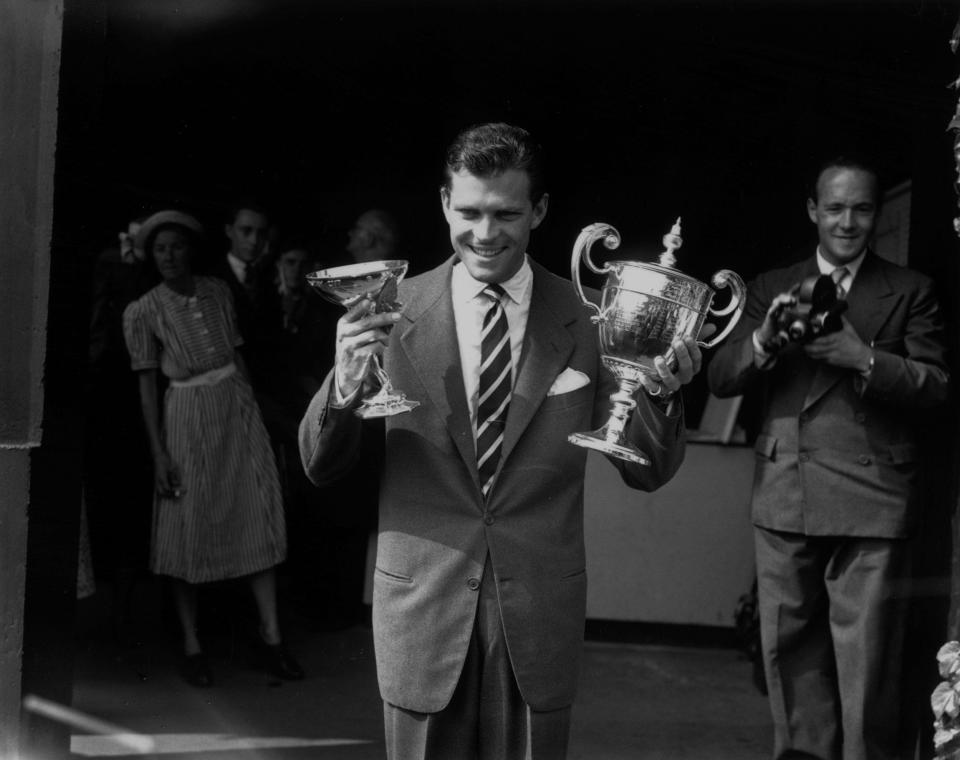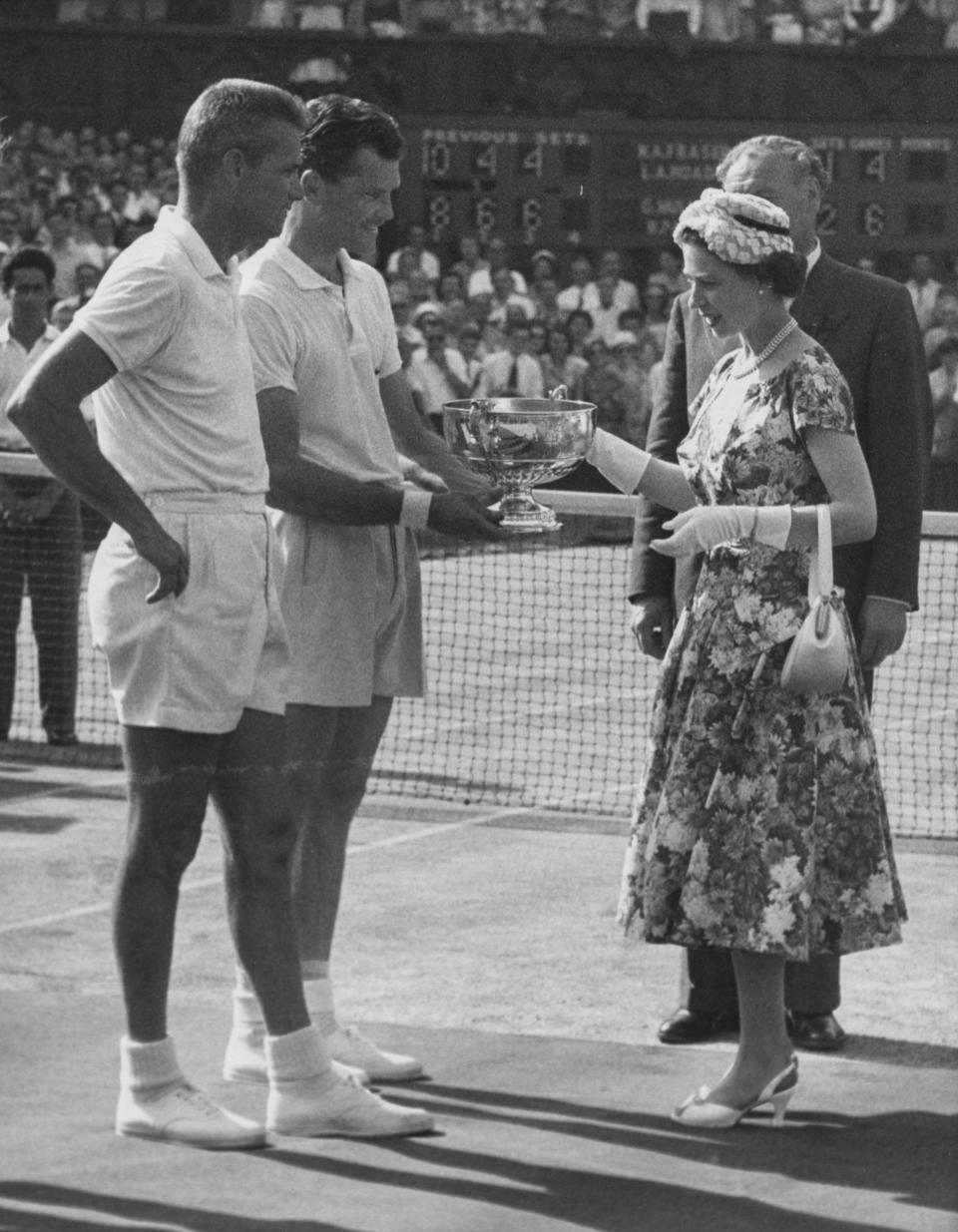Budge Patty, dashing American tennis star of the postwar era who gave up the high life to win back-to-back French and Wimbledon titles – obituary

Budge Patty, who has died aged 97, was one of the half a dozen American tennis stars, including Vic Seixas and Dick Savitt, who dominated the postwar amateur game until the arrival of the brilliant young Australians in the mid-1950s.
Although known initially for his casual approach to training, he enjoyed an annus mirabilis in 1950 when he gave up smoking, and temporarily renounced drinking and his hard-partying lifestyle, to achieve a notable double, taking both the French singles at Roland Garros and the Wimbledon title.
Jesse Edward “Budge” Patty was born on February 11 1924 into a close-knit, sporty family of Austrian émigré stock in Fort Smith, Arkansas, though they moved to Los Angeles when he was a toddler. He showed early talent for all ball-games, and his respectable but impecunious parents, unable to afford tennis club fees, badgered Patty’s elder brother to give him a game on local public courts.
He eventually agreed and was astounded to lose 6-0, 6-0 to the naturally gifted newcomer. The young Patty began playing regularly, though his nickname arose from his reluctance to chase down any balls wide of his racket, causing his brother to yell “Go on. Budge!” to get him moving. His mother always insisted on immaculate sportsmanship and courtly manners from her offspring, attributes which later paid dividends as Patty emerged on the world stage.
Another rising star, the future Grand Slam champion Pauline Betz, five years his senior, spotted his talent and from his early teens practised with him each Saturday morning. Thanks to his rapid improvement and languidly elegant style, he was invited to play at the ritzy Beverly Hills Tennis Club, owned by the former champions Fred Perry and Ellsworth Vines, where most of the top young Californians trained.

Under the aegis of the influential coach Bill Weissbuch he added consistency to his graceful baseline game and also enjoyed hitting with several celebrities, including the film stars Barbara Stanwyck and Robert Taylor. The pair were so impressed by his potential that they began funding his coaching and tournament fees. He soon repaid their trust, winning the US National Under-15 Championship in 1939 and the Under-18s in 1941 and 1942.
Weissbuch, aware that Patty needed to add more bite to his game, cannily arranged for him to play a match against the former champion “Big Bill” Tilden. With his majestic strokes and net-rushing tactics the veteran inflicted a tough lesson as he demolished the youngster 6-0, 6-0.
In his 1951 autobiography Tennis My Way, Patty recalled: “Tilden told me at the end, ‘Sonny, you play a pretty good game of tennis, but you will never be any better than you are right now unless you learn to play a little more aggressive type of game. Learn to volley and attack as much as possible. That’s the only way you’ll ever become a champion’. ”
Patty took the hint, rapidly developing an attacking all-court game and an exquisite forehand volley ranked among the best in the world.
In 1942, a few days after enrolling at the University of Southern California, Patty was called up to the US Army. Six months later he was allowed to leave camp in Salt Lake City each day for three weeks to train for the Utah state championships, and duly won the title. He then spent two years in Italy with the 12th Air Force public relations department before his discharge in January 1946.
While competitive tennis in America had continued as usual during the 1940s, there were few tournaments in Europe and Australia, where most of the leading players were on active service. The combination of high-class competition, good weather and an excellent diet, at a time when Europe was suffering strict rationing, meant that the American stars emerged from the Second World War fit, well-nourished and virtually unbeatable.
It was no coincidence that the four Wimbledon men’s singles champions between 1947 and 1950 were all players brought up in Southern California – Jack Kramer, Bob Falkenburg, Ted Schroeder and Patty himself.

With his Austrian roots and cosmopolitan tastes, however, Patty always insisted he felt more European than American, and from 1946 he based himself in Paris, where his good looks and charisma made him, according to one contemporary, “catnip to the ladies”.
That year, Patty won his first major, the mixed doubles title on the red clay of Roland Garros with his friend and mentor Pauline Betz. Two years later, he advanced to the semi-finals of the French singles, losing a compelling five-setter to the astute Czech left-hander Jaroslav Drobny.
In 1949 he reached the final, losing to his fellow-American Frank Parker, but stung by press criticism of his lack of stamina during long matches, thanks to his taste for high society and fine wines, he decided to take his fitness more seriously, quitting smoking, drinking and late nights and embracing a gruelling physical regime.
This produced immediate results, and the following year he arrived at Roland Garros in the best shape of his life. The British international player, tennis historian and broadcaster John Barrett, playing in his first Grand Slam match, faced Patty in the opening round.
“It was a real baptism of fire,” Barrett recalled. “I broke his serve in the first game, held my own to lead 2-0 and felt pretty bullish – but soon afterwards I somehow found myself 2-6, 0-6 down. Then I won the first game of the third set and that was it. Budge was a wonderful touch player with a superb forehand volley and controlled, subtle placements. He’d put the ball into the places you found most awkward and slice you up, rather than battering you into the ground.”
Patty’s run to the 1950 Wimbledon title was a comparative stroll, with no five-setters. His old rival Drobny lost in the semis to the dogged Australian Frank Sedgman, whom Patty beat comfortably in the final, 6-1, 8-10, 6-2, 6-3. In that amateur era, his prize was a £5 voucher which had to be spent on tennis equipment.

Three years later, Patty and Drobny once again locked horns in a historic third-round battle. Patty held six match points but was eventually beaten 8-6, 16-18, 3-6, 8-6, 12-10 after 4 hours 20 minutes, at the time the longest match ever played at Wimbledon.
His final hurrah was a record-breaking four-set victory in the 1957 Wimbledon doubles final. Aged 33, he and his 43-year old compatriot Gardnar Mulloy outmanoeuvred the overwhelming favourites, Lew Hoad and Neale Fraser of Australia, to become the oldest pair to win the title since the 1910s.
Patty lived the rest of his life in Europe, enjoying café society and working first as a travel agent from his Paris apartment, then in property, while also taking bit parts in films.
In 1961, he married a woman as glamorous and charismatic as himself, Maria Marcina Sfezzo, the daughter of a Brazilian engineering tycoon. The couple moved to Lausanne in Switzerland, where Patty played social tennis several times a week well into his nineties, often using his old wooden rackets.
Christopher Clarey’s 1997 Tennis magazine profile perfectly captured his urbane charm: “Patty’s is a patrician voice, one that conjures up cocktails in the clubhouse, summers on the coast and winters on the slopes.”
He was admitted to the International Tennis Hall of Fame in 1977 and returned to watch Wimbledon each year until 2016. His wife survives him together with their two daughters.
Budge Patty, born February 11 1924, died October 3 2021

 Yahoo News
Yahoo News 
